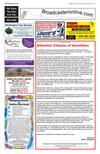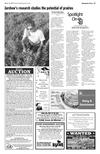9.pdf




09 Broadcaster Press
March 12, 2013 www.broadcasteronline.com
Spring Wheat Planting
BROOKINGS, S.D. - The
most important factors in
producing a profitable
spring wheat field are
selecting the best cultivar,
providing proper fertility,
planting on time and having a good seedbed to
plant into, says Paul O.
Johnson SDSU Extension
Agronomy Field Specialist.
When selecting a variety,
Johnson encourages growers to reference the Variety
Recommendations
for
2013 contained in the
2012 annual report on
Spring Wheat.
"South Dakota has seven
varieties which are recommended statewide and two
which are recommended
for only some of the crop
adaptation regions," he
said. "The 2012 annual
report also provides variety traits. This information can be very helpful
Spring
when picking one of the
recommended varieties to
best fit a given operation."
Things to consider when
planning for 2013
Spring wheat needs to
be planted early in the
spring.
"Normally it should be
planted by the third week
of April or within the first
two weeks of planting possible in the spring.
Producers should check
crop insurance planting
dates for the location to be
planted to ensure coverage," Johnson said.
Spring Wheat is normally planted one to two inches deep in the soil but will
emerge from as deep as
three inches.
"Planting into moisture
will ensure an even stand
at emergence. Uniform
emergence will in turn;
produce a crop that will
mature evenly. This is
desirable at harvest but
also helps for timing pesticide applications throughout the growing season."
he said.
Spring wheat should be
planted at a minimum of
1.2 million pure live seeds
per acre or 28 seeds per
square foot. This translates
into about 1.5 bushels per
acre with average size
spring wheat seed.
Late planting or planting into poor seedbeds
requires a higher seeding
rate. Spring wheat requires
a good fertilizer package to
produce high yields. Fields
should be soil tested to
determine fertilizer needs.
Caution should be taken if
fertilizer is being placed
with the seed. Too high a
rate with the seed can hurt
germination.
GREENS are COMING!
at Heikes Family Farm LLC
Vermillion’s C.S.A.
Single/Family/Comercial Shares Now Available
Annual Shares Good for 32 Weeks of FRESH, LOCAL Produce.
The Spring Share Drive Continues
March 19th National Ag Day • March 20th First Day of Spring
Salad Greens • Tomatoes • Sweet Corn • Cukes • Sweet Corn
Peppers • Potatoes • Onions • Garlic • Raw Local Honey
VISIT heikesfamilyfarm.com
EMAIL HeikesFarm@gmail.com or
Call 605-222-3949
to Reserve Your Share Today!
Community Supported Agriculture
SINCE
1946
Sam Heikes, Owner
1408 317th St.
(Across From Masaba)
Go your own way.
With eight models and a long list of options to choose from, there’s a top-quality Kubota RTV
for your own unique mix of outdoor work and rugged adventure. Schedule a test drive today.
" #
$
Have you seen this pest?
Japanese Beetles in Field Crops
The Japanese beetle
(Popillia japonica) is
becoming an increasingly
prevalent pest in the
North Central region, and
it can occasionally be an
economic problem in soybeans or corn. The
Japanese beetle should
not be confused with the
Asian lady beetle (which
is often called a Japanese
beetle by mistake). Asian
lady beetles are familiar to
many as the yellow or
orange lady beetles that
come into houses in the
fall, and they are beneficial predators of crop
pests. Japanese beetles
are large (up to 1/2 inch
long) and metallic green
and copper colored.
Adults feed on the leaves
and flowers of over 300
plant species. They are an
introduced pest first
found in the U.S. in 1916 in
New Jersey. Only in recent
years have they become
common in the Midwest.
The South Dakota
Department of Agriculture
monitors for this pest
with traps, and it has been
detected in several counties, particularly in the
Southeastern part of the
state.
Japanese beetle immatures are soil-dwelling,
white grubs that feed on
roots and organic material, and they are often
pests of turfgrass.
The adults
typically feed
between the
veins of leaves
causing a characteristic lacy
or
“skeletonized” damage. They feed
on a wide range of plants
including various ornamentals, fruits, and vegetables.
Though they are more
common in horticultural
settings, they will also
feed in field crops, including corn and soybeans. In
soybeans they cause defoliation of leaves, which
reduces photosynthesis,
and in corn they feed on
silks, reducing kernel set.
Though still a minor field
crop pest, Japanese beetle outbreaks are becoming more common in
Illinois and Iowa soybeans
and corn. So far in South
Dakota most reported
problems with Japanese
beetles have been in gardens near urban centers,
but as it becomes more
common in South Dakota,
producers should also be
on the lookout for this
insect in crops.
Japanese beetles have
one generation per year
and overwinter as grubs
in the soil. Adults emerge
from the soil in late May
or early June and can be
found through early
September. Feeding damage is most noticeable in
July and August. Japanese
beetle feeding damage in
soybean may be confused
with bean leaf beetle feeding because both make
holes in the leaves, but
Quickly converts from 2- to 4-passenger seating.
Compact gasoline model ?ts in the back of a long-bed pickup.
Fresh Produce CSA Shares on Sale Now!
402.254.9131
Up your comfort factor with a factory-installed cab.
!
CastleCreekFamilyFarm.com
bean leaf beetle feeding
produces more smoothedged “shot-holes” in the
leaves, whereas Japanese
beetles create a lacy
patchwork of holes
between the veins. Also,
unlike bean leaf beetles,
Japanese beetles are not
shy or skittish and are
usually found easily at the
scene of their crimes.
Damage often appears
first at field edges.
Soybeans can bear a fair
amount of defoliation
before yield is lost, so
modest numbers of
Japanese beetles and
other defoliators can be
tolerated. Consider management when total defoliation from all leaf-feeding
pests reaches 40% in prebloom, 20% during bloom
and pod-fill and 35% from
pod-fill to harvest.
Consider the whole
plant when making this
decision, not just upper
leaves. If beetles are
aggregated in border
rows, consider an edge
treatment first. A number
of pesticides are labeled
for Japanese beetle control in soybean.
Record wheat
production
ROME (AP) — A U.N. food
agency says the world is headed to the second largest wheat
crop on record because of
increased plantings in Europe
and a recovery from drought
in the U.S.
Production is expected to
increase to 690 million tons,
up 4.3 percent from 2012, the
Rome-based Food and
Agriculture Organization
reported Thursday.
The production hike is
expected mostly in Europe
because of increased plantings in response to high prices
and a recovery in yields in
Russia and elsewhere. The
outlook in the U.S. has
improved in recent weeks,
recovering from earlier
drought conditions.
The agency also says the
recently lower price of wheat
kept the FAO's index of global food prices unchanged for
the second consecutive
month in February.
M & S I r r i g a t i o n & Tr e n c h i n g
Diesel model comes in Kubota orange or Realtree® camouflage.
!
www.kubota.com
©Kubota Tractor Corporation, 2012
Realtree® is a registered trademark of Jordan Outdoor Enterprises, Ltd.
Mike Seiner, Owner
Vermillion, SD
605-999-5218
605-624-5594
Mike Seiner, Owner
Vermillion, SD
605-999-5218 • 605-624-5594
Trenching • Grain Bins
Seeds • Irrigation
Grain Bins





















 Previous Page
Previous Page






